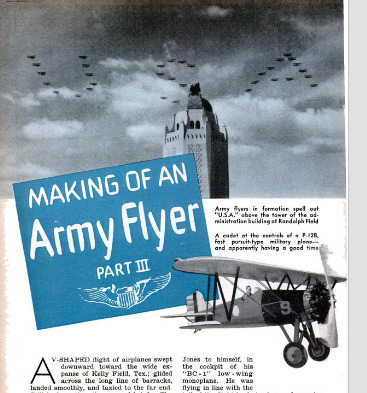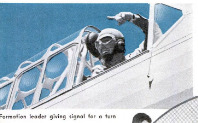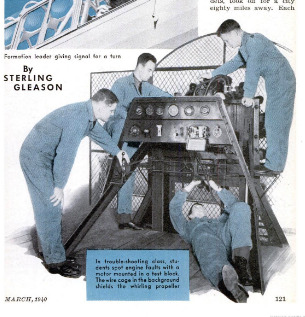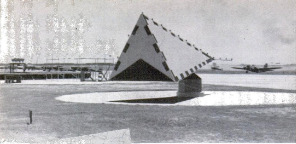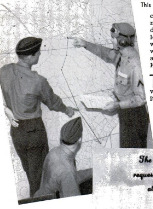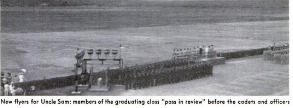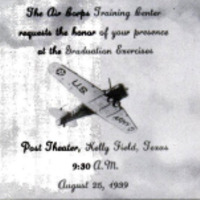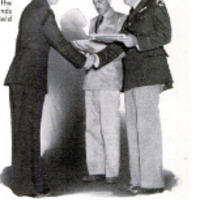-
Title (Dublin Core)
-
Making of an army flyer part III
-
Article Title and/or Image Caption (Dublin Core)
-
Making of an army flyer part III
-
extracted text (Extract Text)
-
AV-SHAPED flight of airplanes swept
downward toward the wide ex-
panse of Kelly Field, Tex.; glided
across the long line of barracks,
landed smoothly, and taxied to the far end.
Still in formation, they paused briefly. The
flight leader’s voice came through the pilots’
headphones: “Ready for take-off again.”https://mobicore.dissgea.unipd.it/admin/item/5164/edit#
In the control tower the dispatcher leaned
toward his microphone: “Control tower to
G Flight formation: All clear for take-off.
Go ahead.”
Keeping their positions, the planes
wheeled, swept down the field and off into
the air, blue fuselages and yellow wings
glinting against the white clouds drifting
in from the Gulf.
“This is real flying!” said Cadet Rick
Jones to himself, in
the cockpit of his
“BC-1" low -wing
monoplane. He was
flying in line with the
tail of the flight leader's plane, a bare wing
span between them. Behind, to the right,
came another V of three planes, and to the
left, still another—all grouped to form a
larger V.
Rick's transfer to the Kelly Field ad-
vanced school after completing his twelve-
week “basic stage” at Randolph Field, had
been uneventful. He checked in at Opera-
tions, was told to read a fat bundle of
printed instructions, and drew an assign-
ment to G Flight, Section III. The para-
chute sergeant ran a tape over his shoul-
ders, fitted the canvas harness snugly, and
stitched it to his measurements. ’'Chute,
clothing, and books were stowed on a flat
wicker frame suspended under his bed in
the long barracks.
Next day the G Flight instructor watched
his technique at the controls and quizzed
him through the interphone: “What is
proper manifold pressure? Do you lean out
the fuel mixture as you go up? How do
you figure the power developed, from the |
‘inches of mercury’ dial on the dash?” |
Rick also was learning to use the radio |
compass, to locate himself and fly in by
this “homing ring.” He mastered the gyro
compass and gyro horizon, then flew blind, |
‘under the hood. Back now
to the Link Trainer,
known as the “jeep,” for
a daring maneuver, the
famous “Army Two-Sta-
tion Let-Down.”
Then, back to the air
again. The instructor,
leading half a dozen ca-
dets, took off for a city
eighty miles away. Each
cadet branched out to a different point, and
navigated back to fall in line again at a
designated location. Only thirty seconds’
leeway was allowed for the meeting. It
was quite a feather in the cap of G Flight
when the entire group completed the “time-
and-distance problem” by stringing into
Kelly Field scarcely 100 yards apart.
THE sun was sinking across the flat Texas
Toe as Rick took off from Browns-
ville. To the left, the Rio Grande wriggled
its sluggish way toward the Gulf, dimly
visible in the eastern haze. Before and
behind, Section III was strung out over
a dozen miles. Every three minutes a
cadet joined the flight, the long-awaited
cross-country “mission” climaxing the
whole course of training.
As the dusk deepened,
a single point of light
winked ahead. Rick
flicked on his navigation
lights, set the rudder
fletner and stabilizer,
leaving the plane to fly
itself hands-off, and set-
tled back for a comfort-
able ride. A second light
appeared in the distance.
Looking back, he saw a
third beacon. He was
accurately on course, a
straight flight that
would land him at Kelly
Field, 300 miles away,
within the allotted time.
It was quite dark, except for an occa-
sional patch of lights on the distant horizon,
with only the line of beacons visible. But
he noticed that the distant light swam
hazily. The one he had just passed quickly
dimmed, the third had disappeared.
“When you see only two lights, be care-
ful; when only one, look for a spot to land.”
That was the G Flight instructor's last
word before they left Brownsville. Rick
reached for his flash light and consulted
the map strapped to his knee.
Fifty minutes at 120 miles an hour placed
him 100 miles north of Brownsville. There
was gas enough to carry him to San An-
tonio, with an hour’s supply in reserve. He
twirled the radio knob for weather reports,
but no luck.
Splash! A drop of moisture landed on
the back of his
neck. He looked; the glass cockpit cover was
streaked with rain. A heavy rumble crashed, |
a blinding flash showed heavy, massed |
clouds. The lights below were gone. No bea- |
con, no stars—nothing but blackness. He
turned the radio knob again. Not even the |
crackle of static could be heard; lightning |
must have put the set out of commission. |
“It's an uncharted squall line,” thought |
Rick, mindful of hangar tales of sudden
storms that rose in the South and swept up |
out of uncharted Mexico.
A burst of wind flung the plane upward
at a terrific rate. The altimeter fairly spun.
Rick leaned forward on the stick. For a
split second he bad a horrible sensation that |
the elevator controls had broken loose, for |
the plane failed to respond. Then he mo-
ticed the gyro horizon. The white wings of |
the miniature airplane indicator had fallen |
far below the “level flight” lines. The ship
must be nosed almost straight down, but he
still was rising.
With a sudden rush, the up current ceased |
and Rick found himself abruptly in a power
dive, He pulled out gradually at a slant
that put him on the level prescribed for the
flicht Rut the nrohlem remained |
By rule, he should turn back and land at
once. But where? A sudden juall like
this probably would be of small extent.
Five miles farther, the air might be per-
fectly clear. Probably most of the planes
ahead had missed the storm entirely; so
might those behind him. There'd be talk in
the barracks if he should be the only pilot
who didn’t make it; quiet smiles—or worse,
sympathy.
That was assuming, though, that he did
not have to buck too much head wind, and
that Kelly Field was clear and could be lo-
cated without delay. On the other hand,
Brownsville was nearer and the storm
seemed to be moving northeast. Chances of
clear weather were better behind him. He
knew what the stage commander would
think, what his instructors would say:
“Dead pilots aren't much good to the
Army. You are flying a $30,000 airplane
and the Air Corps needs every one.”
Rick set his gyro at zero, swung into a
circle, made a 180° turn, and headed back.
Sheet lightning flashed on his right, expos-
ing heavy rolling clouds, black with rain.
No lights in sight. The rain beat harder on
the windshield, trickled dismally through
the cracks between the sliding sections, onto
his ankles. Again he consulted his map.
Soon he should pick up a green marker
beacon flashing two dots and a dash every
fourteen seconds—emergency landing field.
But there was only blackness ahead.
A burst of lightning showed a hole in the
clouds. He put his rudder over, made a bee
line for it, and dived. Another flash re-
vealed three small buildings and a broad
plowed field.
Rick made a wide circle and pulled the
handle of the flare release. A tremendous
burst of white light flared out. Crabbing
right to offset the wind, Rick put the nose
down into a regulation glide. He pushed a
big lever below the dash, poked a button;
heard the “clonk . . . clonk” of the retract-
able landing gear as its electrically driven
mechanism swung it free from its anchor-
age and snapped the heavy carriage into
place. At 200 feet he set the automatic
landing flaps, and soon was settling heav-
ily. Carefully keeping the nose out of a
stall, he bumped to a jolting landing.
Rick shrugged out of his parachute har-
ness and climbed out of the cockpit. He at-
tached ropes to wing-tip lugs and the tail
wheel; drove down steel anchor stakes, and
stretched a canvas cover over the motor.
As he finished securing the plane for the
night, footsteps squished behind him.
“Army boy, eh? Are ye hurt?” It was
a farmer, carrying a lantern. “Well, come
on up to the house and we'll put you up in
the spare room.’
Half an hour later, Rick was sipping hot
coffee and talking on the telephone with the
Operations Office. “You're not the only one
of the flight that met weather,” he was told.
“Four others set down at wayside fields, but
you're the first to make a real emergency
landing. Let us know if you need anybody
to fly you out.”
SPLENDID in blue and gold, a nine-plane
“V" formation roared over Operations
Headquarters; over the slate-blue ranks of
undergraduate cadets standing at attention,
and the crowd of spectators grouped around
their automobiles. Flight by flight, the en-
tire graduating class passed in review. An
Hour later, in the post auditorium, an Air
Corps colonel concluded the address of the
day:
“You have just completed a year of more
grueling work than can probably be found
in any other institution except the sister
school of the Navy at Pensacola. . . .Your
country has given you wings: Use them for
its advancement!”
-
Contributor (Dublin Core)
-
Sterling Gleason (article writer)
-
Language (Dublin Core)
-
eng
-
Date Issued (Dublin Core)
-
1940-03
-
pages (Bibliographic Ontology)
-
120-123, 236
-
Rights (Dublin Core)
-
Public domain
-
References (Dublin Core)
-
P-12B
-
Archived by (Dublin Core)
-
Sami Akbiyik
-
Marco Bortolami (editor)
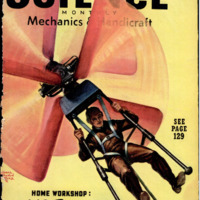 Popular Science Monthly, v. 136, n. 3, 1940
Popular Science Monthly, v. 136, n. 3, 1940

